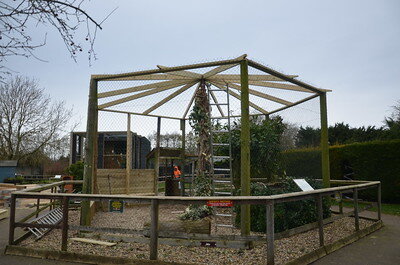It’s almost a year since the pandemic closed our gates. We were fortunate to be able to reopen towards the end of the summer season and enjoyed a few months of “business as usual”, albeit with restricted numbers, social distancing and extra cleaning and washing going on. We closed our gates again in December, in response to the outbreak of Avian Influenza, and have remained closed to visitors as part of the nationwide lockdown since, although our hospital has remained open throughout.
BUT…we have not been idle during this time!
Last year during the summer lockdown, we built some new off-show aviaries to give some of our birds a break during their annual moult. These will also be used for some of our breeding birds and can be furnished with suitable perches and boxes as necessary. We are grateful to a local manufacturer who donated wood offcuts to us, which has enabled us to create a variety of new perches and nest boxes for our aviaries.
Over the winter, we took the decision to cut back the Rhododendron hedge between Ozzie the Kookaburra and our Flying Team aviaries. Winter is the best time of year to cut back hedging as you’ll cause the least disturbance to wild birds, and whilst the resident Starling flock have lost this roost, there are plenty of alternatives they can choose from in the vicinity of Stonham Barns. This has not only lessened the risk of having the wild birds near our aviaries, but has also let in much more natural light to an otherwise relatively dark area of the Sanctuary. We’re sure Ozzie is enjoying a bit more sunshine now!
We’ve also replaced the fencing around our Children’s Play Area.
Last week, work began on improving one of our original octagonal aviaries, which has stood for 25 years! Mir, our Steppe Eagle who took up residence here around the same time, has been temporarily moved to another aviary while the work was carried out. This has involved removing all of the wire mesh and cutting back the vegetation which is a natural feature of this aviary. We then replaced the mesh on the roof and most of the sides, but have enclosed a couple of sides which face into the prevailing wind. This will give the residents a bit more shelter from inclement weather. We also added a hatch, which will allow us to put flying team members into this aviary in the future.
With a reopening date coming up soon (hopefully the 12th April), our attentions are now turning back to the birds and getting them ready for meeting the public again, so make a note in your diary.
Our Advance Booking system will be open from March 20th and we look forward to seeing you again soon.

































































